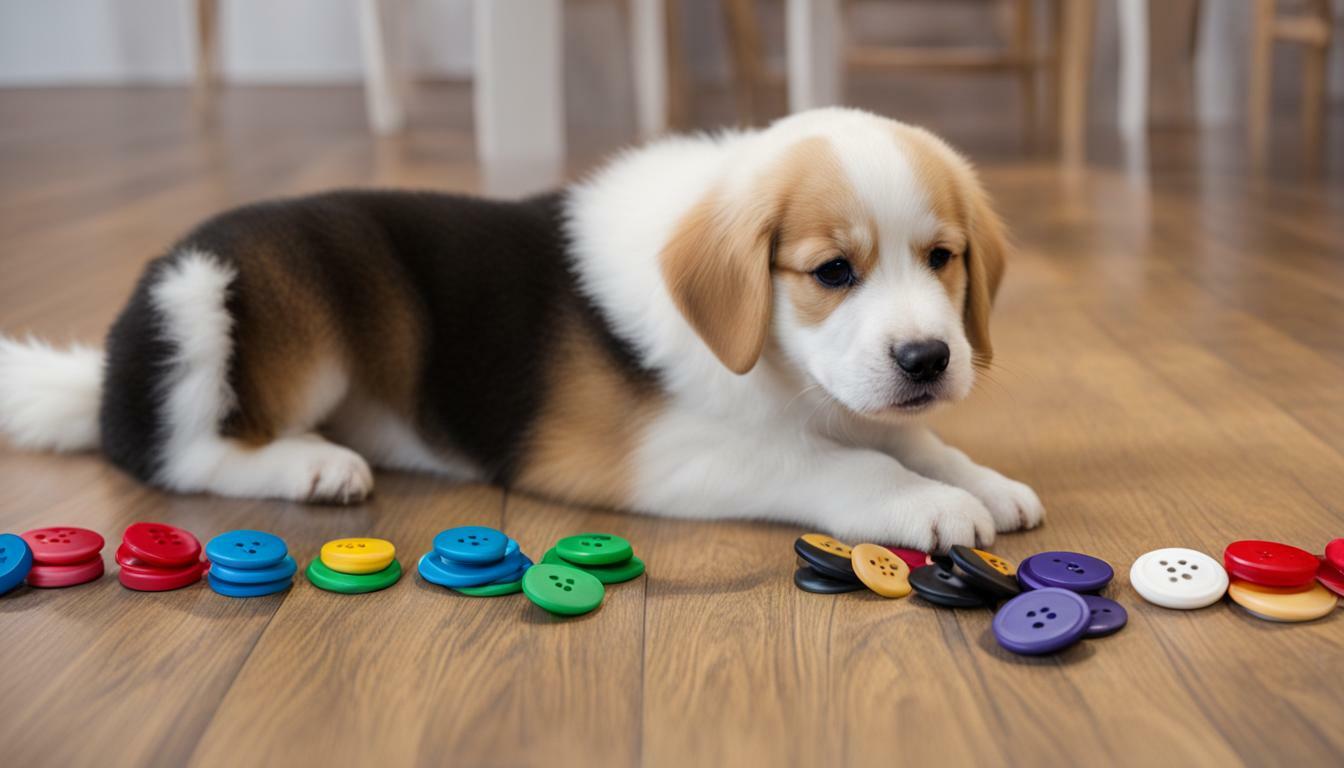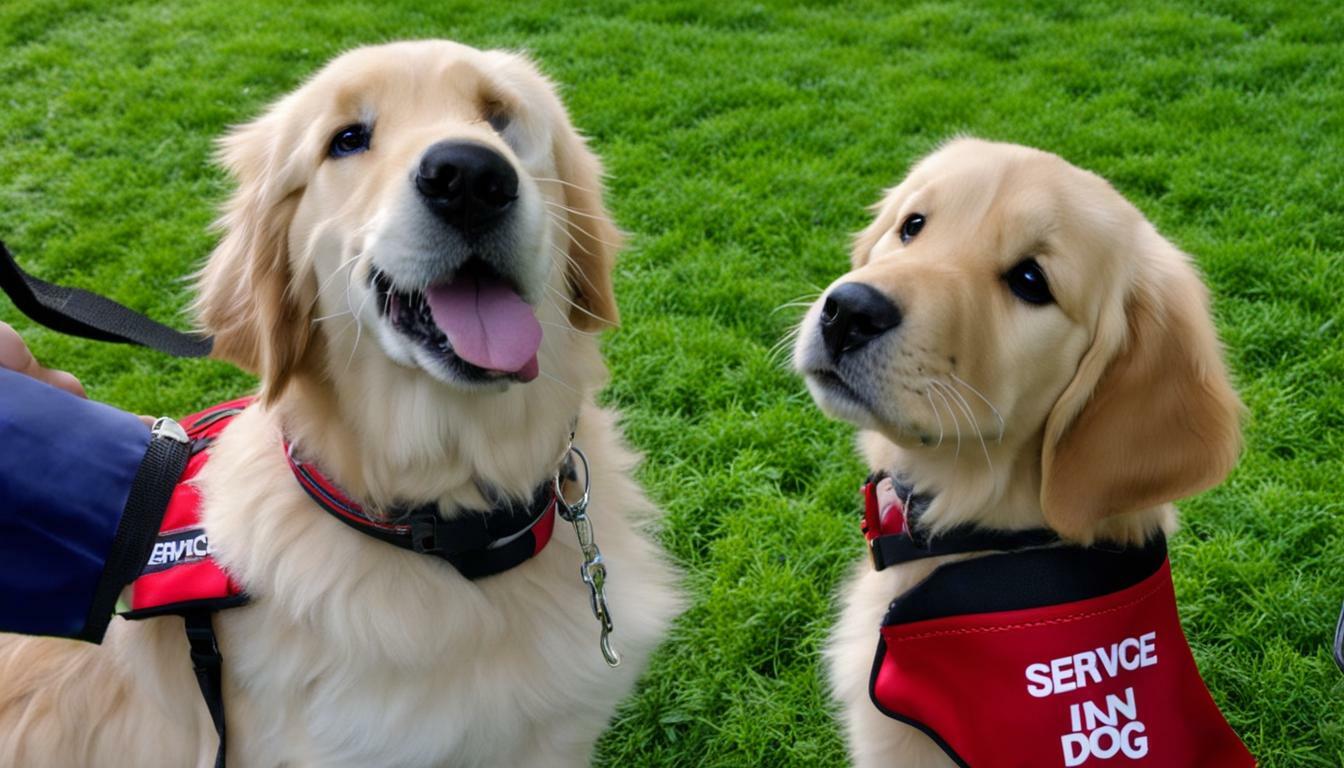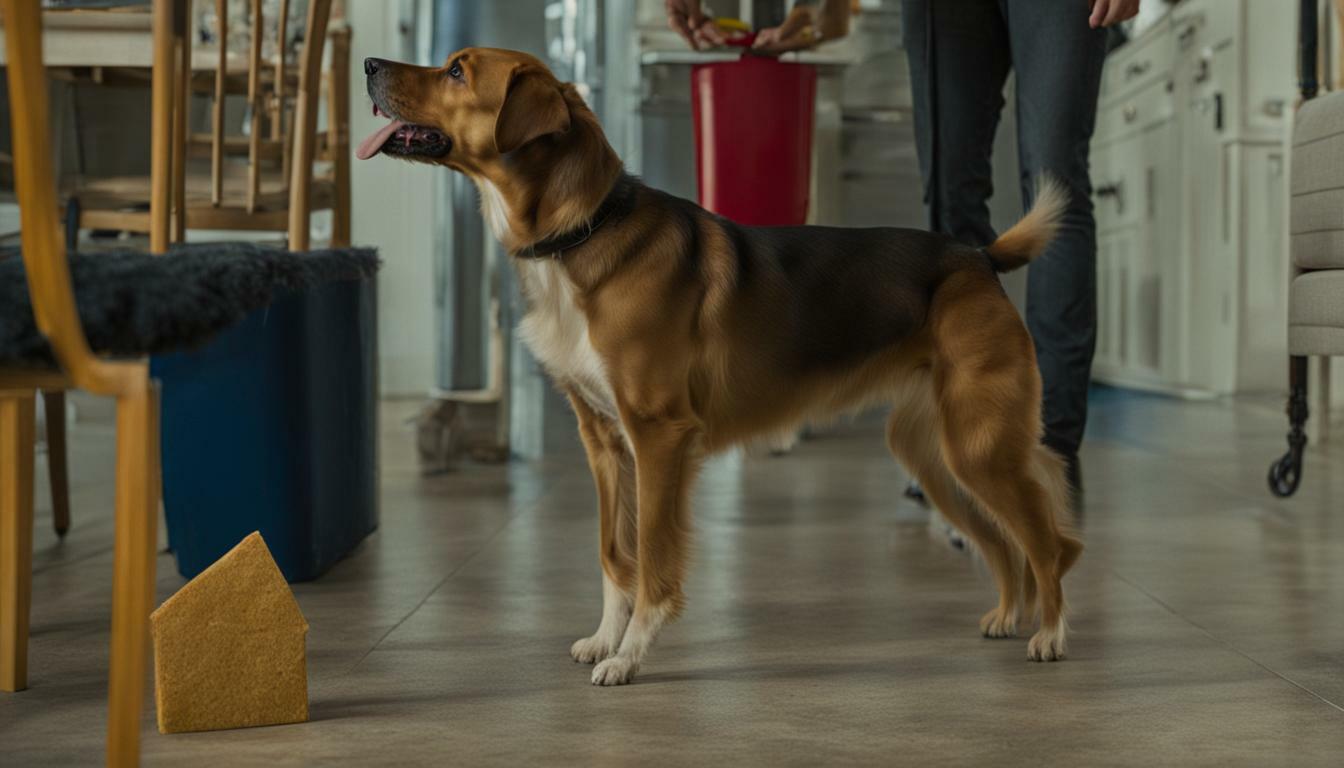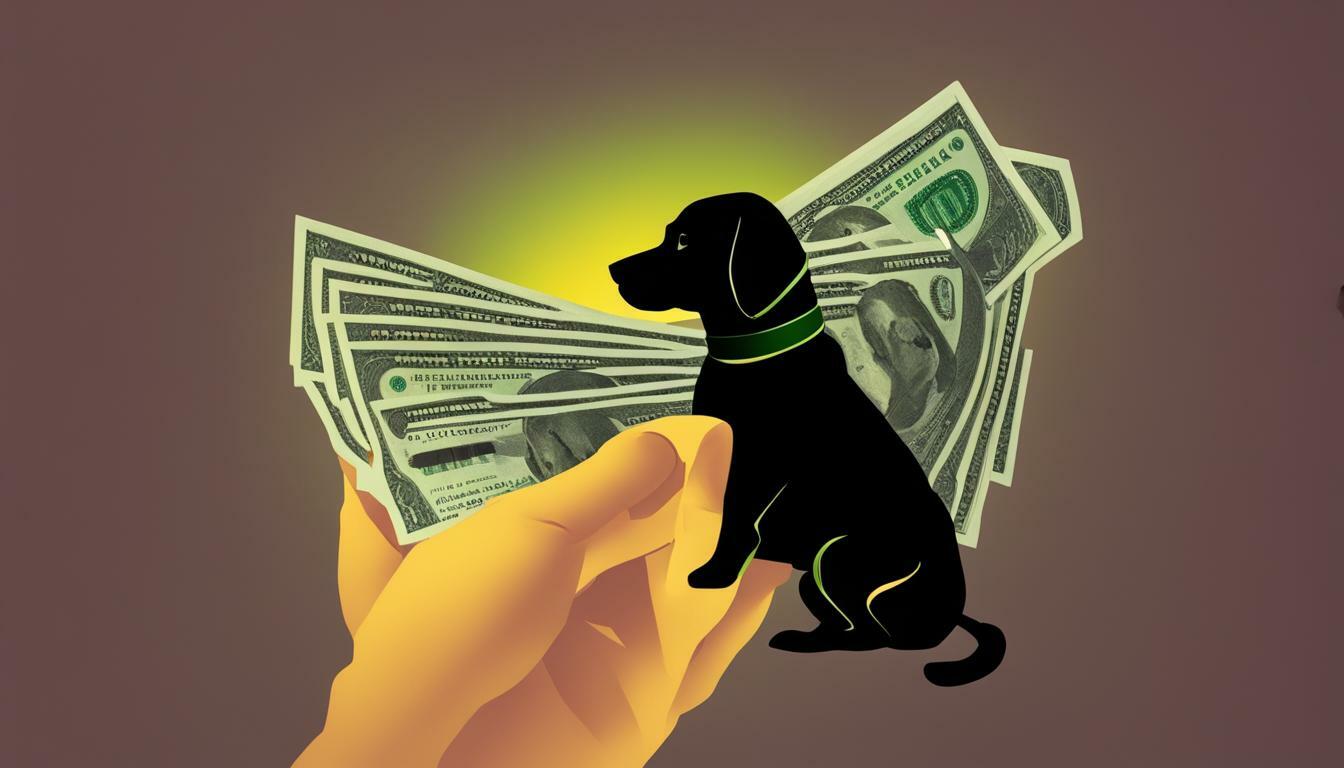Training your dog with an invisible fence is a safe and effective method to provide them with freedom while keeping them secure within boundaries. By understanding the concept and responsible usage of the system, you can ensure a successful training experience for both you and your furry friend.
An invisible fence can be installed underground or with a transmitter, creating an invisible boundary for your dog. The dog wears a radio collar that receives signals from the transmitter, which emits an audible signal and a static correction if the dog crosses the boundary. It is essential to train your dog to understand and respect these boundaries to keep them safe and prevent any unnecessary corrective stimulations.
During training, it is important to teach your dog the boundaries using visual markers and a long leash. These aids will help them understand the limits of their designated area. Positive reinforcement with treats and toys will also encourage your dog to stay within the boundaries and reinforce their training.
Supervision is crucial during the training process to ensure that your dog does not become confused or fearful. Avoid unnecessary negative stimuli corrections, as they can create confusion and hinder the training progress. Remember, consistency and patience are key to successful training.
While various dog breeds can be trained with an invisible fence, such as Australian Shepherds, Border Collies, Boxers, Goldendoodles, Labrador Retrievers, and more, it is important to understand that individual breeds may require specific considerations. Always adapt your training techniques to suit your dog’s specific needs.
When it comes to training cats with an invisible fence, the principles are similar to training dogs. Consistency and patience are key in helping your feline friends learn and respect their boundaries. With time and consistent training, even cats can successfully adapt to an invisible fence system.
Key Takeaways:
- Training with an invisible fence provides freedom and security for your dog within boundaries.
- Install an underground or transmitter-based invisible fence system.
- Teach your dog the boundaries using visual markers and a long leash.
- Use positive reinforcement with treats and toys during training.
- Supervise the training process and avoid unnecessary negative stimuli corrections.
Understanding the Invisible Fence System
To successfully train your dog with an invisible fence, it is crucial to have a good understanding of how the system works and implement effective training techniques. An invisible fence can be installed underground or with the use of a transmitter, creating a boundary for your beloved pet. The system works by having your dog wear a radio collar that receives signals from the transmitter.
When your dog approaches the boundary, the collar emits an audible signal as a warning. If your dog continues to cross the boundary, a static correction is delivered through the collar. It’s important to note that this correction is not harmful to your furry friend, but rather acts as a deterrent to discourage them from crossing the boundary.
| Key Points: | Training Techniques |
|---|---|
| 1. | Teach your dog the boundaries of the invisible fence. |
| 2. | Provide a signal prior to the corrective stimulus. |
| 3. | Use visual markers and a long leash during training. |
| 4. | Utilize positive reinforcement with treats and toys. |
To ensure effective training, it’s essential to supervise your dog during the training process and avoid unnecessary negative stimuli corrections. Consistency is key when signaling the boundaries and providing positive reinforcement. Remember, different breeds may require specific considerations, but with proper training techniques, breeds like Australian Shepherds, Border Collies, Boxers, Goldendoodles, Labrador Retrievers, and more can all be successfully trained with an invisible fence.
Not only can dogs be trained with an invisible fence, but cats can also follow similar training principles. Training cats requires consistency and patience, just like with dogs. Starting training at a young age is ideal, as puppies as young as eight weeks old can begin their training with an invisible fence. By ensuring proper training techniques, you can avoid confusion and fear in your pets and maximize the effectiveness of the invisible fence system.
When it comes to invisible fence solutions, Invisible Fence® has been a trusted name in the industry since 1973. They provide innovative solutions and comprehensive training for pet owners, ensuring the safety and well-being of your furry friends. With their expertise, you can master the art of training your dog with an invisible fence, giving them the freedom to explore within safe boundaries.
Training Steps for Your Dog
Training your dog with an invisible fence requires a systematic approach and consistent effort to ensure their understanding and respect for the boundaries. It is essential to provide clear signals and positive reinforcement to reinforce the desired behavior. Here are some key steps to help you train your dog effectively:
- Begin by introducing your dog to the boundaries of the invisible fence system. Use visual markers, such as flags or stakes, to clearly define the limits. Walk your dog around the perimeter on a leash so they can become familiar with the boundaries.
- Next, put your dog on a long leash and allow them to roam within the boundaries. Use the audible signal from the radio collar to provide a warning sound when they approach the boundary. This helps them associate the sound with the boundary and understand that they should not cross it.
- If your dog continues towards the boundary despite the warning sound, they may receive a static correction. It is crucial to ensure that the static correction is set at an appropriate level and does not cause any harm to your dog. This correction should only serve as a deterrent rather than punishment.
- Consistency is key in training. Repeat the above steps regularly and supervise your dog during the training process. Be patient and provide positive reinforcement, such as treats or toys, when your dog stays within the boundaries. This helps reinforce the desired behavior and strengthens their understanding of the system.
Remember, training your dog with an invisible fence requires time and effort. Stay committed to the process, and your dog will eventually learn to respect the boundaries and enjoy the freedom of a safe and secure outdoor area.
| Training Steps for Your Dog |
|---|
| 1. Introduce your dog to the boundaries using visual markers. |
| 2. Use the audible signal to provide a warning when your dog approaches the boundary. |
| 3. Set the static correction at an appropriate level as a deterrent. |
| 4. Be consistent, patient, and provide positive reinforcement for staying within the boundaries. |
Invisible Fence Training for Different Dog Breeds
Invisible fence training methods can be applied to a wide range of dog breeds, ensuring their safety and freedom within set boundaries. Whether you have an Australian Shepherd, Border Collie, Boxer, Goldendoodle, Labrador Retriever, or any other breed, the principles of training with an invisible fence remain the same.
During the training process, it is essential to teach your dog the boundaries of the invisible fence. Visual markers and a long leash can aid in providing a clear understanding of the designated area. Positive reinforcement plays a vital role, using treats and toys to reward your dog for staying within the boundaries.
Supervision is crucial during training to ensure that unnecessary negative stimuli corrections are avoided. Consistency is key, both in signaling the boundaries and providing positive reinforcement. By following these training techniques, you can successfully teach your dog to respect the invisible fence and enjoy the freedom it provides.
| Dog Breed | Training Adaptations |
|---|---|
| Australian Shepherd | Highly intelligent and active, may require additional mental and physical stimulation during training. |
| Border Collie | Known for their herding instincts, may need extra guidance to prevent them from attempting to herd people or other animals near the boundaries. |
| Boxer | Playful and energetic, may require additional reinforcement to redirect their focus and prevent them from testing the boundaries. |
| Goldendoodle | Intelligent and easily trainable, consistency and positive reinforcement are key factors in successful training. |
| Labrador Retriever | Active and eager to please, may benefit from a combination of physical exercise and mental stimulation during training. |
Remember, every dog is unique, and while the training methods remain the same, individual breeds may have specific considerations. By understanding their breed traits and adapting the training techniques accordingly, you can ensure that your dog thrives within the invisible fence boundaries, enjoying both safety and freedom.
Static Correction and its Effectiveness
The static correction provided by the invisible fence collar is a key element in training your dog to respect the boundaries and foster their safety. While it may sound intimidating, it’s important to understand that the static correction is not harmful to your furry friend. Instead, it serves as a deterrent to prevent them from crossing the boundary and potentially putting themselves in danger.
During the training process, your dog will learn to associate the audible signal with the boundary and receive a static correction only if they continue to approach or cross it. This helps them understand the consequences of their actions and encourages them to stay within the safe confines of your yard.
When implementing the static correction, it’s crucial to ensure that you use effective training techniques. Positive reinforcement is key to reinforce the desired behavior. Remember to reward your dog with treats and praise when they stay within the boundaries and avoid crossing them. This will create a positive association and further motivate them to follow the rules.
| Dog Breed | Invisible Fence Compatibility |
|---|---|
| Australian Shepherds | Compatible |
| Border Collies | Compatible |
| Boxers | Compatible |
| Goldendoodles | Compatible |
| Labrador Retrievers | Compatible |
The Training Process for an Invisible Fence
- Introduce your dog to the invisible fence system gradually. Start with short training sessions in a controlled environment.
- Teach your dog to recognize the boundary flags or other visual markers that indicate the boundary limits.
- Use a long leash during training to provide guidance and prevent your dog from accidentally crossing the boundary.
- Pair the audible signal with the static correction so that your dog associates the warning sound with the possibility of receiving a correction.
- Supervise your dog closely during the training process and be consistent in providing positive reinforcement for staying within the boundaries.
By following these steps and utilizing the static correction effectively, you can ensure that your dog understands the invisible fence system and remains safe within your property. Remember, the training process may take time and patience, but the end result will be a well-trained, boundary-respecting companion.
Invisible Fence Training for Cats
Cats can also be trained to respect the boundaries of an invisible fence system when provided with consistent training and patient guidance. While training cats may require a slightly different approach compared to dogs, the principles remain the same.
Consistency is key when training cats with an invisible fence. Start by introducing your cat to the boundaries of the system gradually. Allow them to explore the designated area while keeping a watchful eye. Use visual markers, such as flags or temporary fencing, to help them understand the boundaries visually.
Patience is crucial during the training process. Cats may take longer to adjust compared to dogs, so it’s important to give them time to understand the system. Use positive reinforcement techniques, such as treats or toys, to reward your cat when they stay within the boundaries. This will help them associate staying within the designated area with positive experiences.
Tips for Training Cats with an Invisible Fence
- Start training your cat at a young age to establish good habits early on.
- Provide a safe and stimulating environment for your cat within the boundaries of the invisible fence.
- Avoid using negative stimuli, as it can create fear and confusion in cats.
- Use consistency in signaling the boundaries of the invisible fence to prevent confusion.
- Supervise your cat during the training process to ensure their safety.
With consistent training and patient guidance, cats can learn to respect the boundaries of an invisible fence system, providing them with the freedom to explore while keeping them safe and protected.
| Breed | Characteristics |
|---|---|
| Australian Shepherds | Intelligent and energetic |
| Border Collies | Highly trainable and active |
| Boxers | Friendly and playful |
| Goldendoodles | Affectionate and adaptable |
| Labrador Retrievers | Loyal and friendly |
Starting Training at a Young Age
Starting training your puppy with an invisible fence at a young age is essential for them to grow up understanding and respecting the boundaries. An invisible fence system creates a boundary for your dog, either by being installed underground or through a transmitter. The dog wears a radio collar that receives signals from the transmitter, ensuring they receive the correct stimuli when approaching the boundary.
During the training process, it’s important to provide visual markers and a long leash to guide your puppy and reinforce the boundaries. Positive reinforcement with treats and toys helps them associate staying within the designated area with rewards. Remember, training should always be supervised, and it’s crucial to avoid unnecessary negative stimuli corrections, which can confuse or frighten your furry friend.
Training Techniques for Invisible Fence
Training your puppy with an invisible fence involves consistency and patience. It can take a minimum of three weeks for them to fully comprehend the boundaries. To ensure an effective training outcome, it’s important to provide clear sign
Ensuring Effective Training and Avoiding Confusion
Effective training techniques are essential to ensure your dog understands the invisible fence system and remains confident and secure within the designated boundaries. Consistency in signaling the boundaries and providing positive reinforcement is key to avoiding confusion and fear in your pet. By following these guidelines, you can ensure a successful training experience.
Important Training Techniques:
- Supervise the training: It is crucial to supervise your dog during the training process. This allows you to monitor their progress and correct any unwanted behavior immediately. Remember to provide praise and rewards when your dog demonstrates the desired behavior within the boundaries.
- Establish clear boundaries: Use visual markers and a long leash to help your dog understand the boundaries. Start by walking with them along the perimeter while using verbal cues and hand signals. This reinforces their understanding of where they can and cannot go.
- Positive reinforcement: Reward your dog with treats and toys when they remain within the boundaries. This positive reinforcement helps them associate staying within the invisible fence with pleasurable experiences. Consistency is key in reinforcing this behavior.
- Avoid unnecessary corrections: While static correction is a part of the training process, it is important to use it judiciously. Unnecessary corrections can lead to confusion and fear in your dog. Only use the static correction when your dog crosses the boundary and remember to provide the audible signal beforehand as a warning.
By implementing these training techniques, you can ensure that your dog understands the invisible fence system and feels confident and secure within the designated boundaries. Remember to be patient and consistent throughout the training process, as it may take several weeks for your dog to fully grasp the concept. Always prioritize their safety and well-being.
Trusted Name in Invisible Fence Solutions
When it comes to invisible fence solutions, Invisible Fence® is a trusted name you can rely on. With over 45 years of experience, Invisible Fence® has been providing innovative solutions and training for pet owners since 1973. Their commitment to ensuring the effectiveness of invisible fence systems sets them apart as a leader in the industry.
With their expertise and dedication to pet safety, Invisible Fence® offers a comprehensive range of products and services to meet the individual needs of every dog owner. Whether you have a mischievous Australian Shepherd, an energetic Border Collie, an enthusiastic Boxer, a playful Goldendoodle, or a loyal Labrador Retriever, Invisible Fence® can provide the right training solutions for your beloved furry friend.
Choose Invisible Fence® for effective, reliable, and safe training solutions that will keep your dog secure within the boundaries of your invisible fence system.
| Benefits of Invisible Fence® | Why Choose Invisible Fence® |
|---|---|
| 1. Keeps your dog safe and secure | 1. Over 45 years of experience in the industry |
| 2. Customizable solutions for different breeds | 2. Innovative and reliable products and services |
| 3. Trusted by thousands of satisfied customers | 3. Commitment to pet safety and well-being |
The Timeframe for Training
Training your dog with an invisible fence requires dedication and consistency, with the average timeframe for full training taking at least three weeks. During this period, it is important to remain patient and consistent in your training approach to ensure the effectiveness of the invisible fence system as a whole.
Consistency is key when teaching your dog to respect the boundaries set by the invisible fence. By reinforcing the boundaries consistently and providing positive reinforcement when the dog stays within the designated area, they will learn to associate staying within the boundary with rewards and praise.
During the training process, it is crucial to closely supervise your dog to prevent any unnecessary negative stimuli corrections. This will help avoid confusing or scaring your pet, allowing them to learn the boundaries more effectively. It is also recommended to avoid leaving your dog unsupervised during the training phase to ensure their safety.
Puppies as young as eight weeks old can start their training with an invisible fence, and starting at a young age is beneficial in establishing good habits early on. By introducing the invisible fence system to your puppy at a young age, they will grow up familiar and comfortable with the boundaries, making the training process smoother and more successful.
| Training Tips for Invisible Fence | |
|---|---|
| Remain patient and consistent throughout the training process. | |
| Supervise your dog closely to prevent unnecessary negative stimuli corrections. | |
| Start training your puppy with an invisible fence from a young age. |
Invisible Fence® has been a trusted provider of innovative solutions and training for pet owners since 1973. Their expertise and commitment to ensuring the effectiveness of invisible fence systems make them a reputable choice for those looking to train their pets with this technology. By following the recommended training techniques and remaining consistent throughout the process, you can successfully train your dog to respect the boundaries of an invisible fence.
The Trusted Name in Invisible Fence Solutions
When it comes to invisible fence solutions, Invisible Fence® has been a trusted name in the industry since 1973, providing innovative solutions and quality training methods for pet owners. Mastering how to train your dog with an invisible fence involves understanding the concept and responsible usage of the system.
An invisible fence can be installed underground or with a transmitter, creating a boundary for your dog. The dog wears a radio collar that receives signals from the transmitter. The collar emits an audible signal and a static correction if the dog crosses the boundary. Responsible training includes teaching the dog the boundaries and providing a signal prior to the corrective stimulus.
During the training process, visual markers and a long leash can assist in teaching your dog the boundaries. Positive reinforcement with treats and toys is also important to reinforce their understanding of the invisible fence. It’s crucial to supervise the training process and avoid unnecessary negative stimuli corrections, as consistency and patience are key to successful training.
Not only can various dog breeds, including Australian Shepherds, Border Collies, Boxers, Goldendoodles, Labrador Retrievers, and more, be successfully trained with an invisible fence, but cats can also benefit from this training method. Training cats follows similar principles as training dogs, emphasizing the importance of consistency and patience.
The training process for an invisible fence can take a minimum of three weeks, and it’s recommended to start training puppies as young as eight weeks old. Proper training techniques are essential to ensure the effectiveness of the system and to avoid confusion and fear in pets. That’s where Invisible Fence® with their expertise and commitment to providing reliable invisible fence systems can help.
Invisible Fence® has been at the forefront of the industry, continuously improving their products and training methods to ensure the safety of pets. With their vast experience and dedication, pet owners can trust Invisible Fence® to provide innovative solutions that keep their beloved pets secure within the boundaries of their home.
FAQ
What is an invisible fence?
An invisible fence is a system that creates a boundary for your dog using an underground installation or a transmitter. The dog wears a radio collar that receives signals from the transmitter, emitting an audible signal and static correction if the dog crosses the boundary.
How do I train my dog with an invisible fence?
Responsible training includes teaching your dog the boundaries and providing a signal prior to the corrective stimulus. Visual markers and a long leash can assist in training, and positive reinforcement with treats and toys is important. Training should not be done unsupervised, and unnecessary negative stimuli corrections should be avoided.
Can all dog breeds be trained with an invisible fence?
Yes, various dog breeds, including Australian Shepherds, Border Collies, Boxers, Goldendoodles, Labrador Retrievers, and more, can be successfully trained with an invisible fence. While the training methods remain the same, individual breeds may require specific considerations.
Is the static correction harmful to my dog?
No, the static correction emitted by the collar is not harmful to the dog but acts as a deterrent. It is important to ensure proper training techniques are used to effectively communicate the consequences of crossing the invisible fence.
Can I train my cat with an invisible fence?
Yes, training cats with an invisible fence follows similar principles as training dogs. Consistency and patience are crucial during the training process.
From what age can I start training my dog with an invisible fence?
Puppies as young as eight weeks old can start their training with an invisible fence. Proper training from a young age is essential to ensure the effectiveness of the system in keeping them safe.
How long does the training process take?
The training process for an invisible fence can take a minimum of three weeks. Consistency and patience are key during this period to ensure the dog fully comprehends the boundaries.
How can I ensure effective training and avoid confusion?
Proper training techniques, such as consistency in signaling the boundaries and providing positive reinforcement, are essential to avoid confusion and fear in pets.
Who is Invisible Fence®?
Invisible Fence® is a trusted name in providing innovative solutions and training for pet owners since 1973. They are experts in ensuring the effectiveness of invisible fence systems.
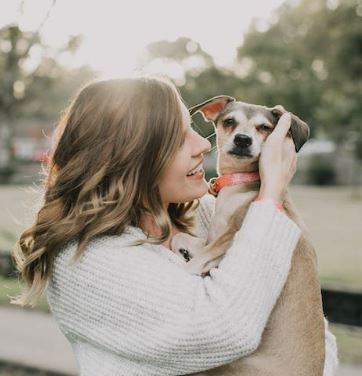
Marissa Delotta, 36, from Dayton, Ohio, is the creative force behind Roverboard.com, a beloved online destination for dog lovers. As a dedicated mom and canine enthusiast, Marissa combines her family experiences with her love for dogs to offer a platform where dog owners can exchange tips, heartwarming stories, and advice. Her website has become a vibrant community for sharing the joys of dog parenting. In her free time, Marissa enjoys exploring dog parks with her family and volunteering at local animal shelters.


